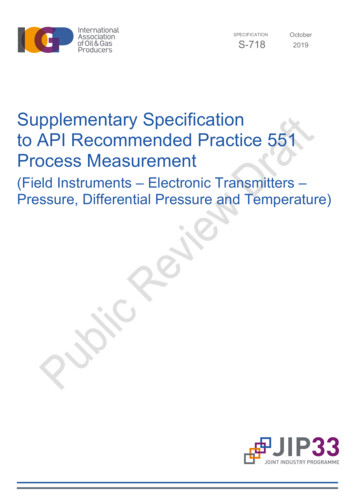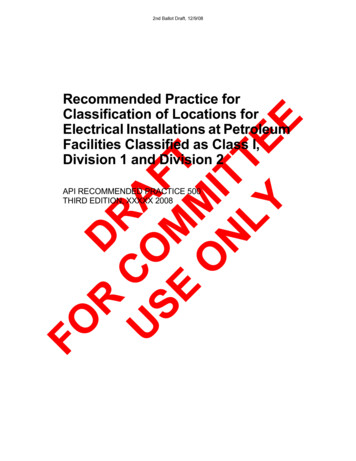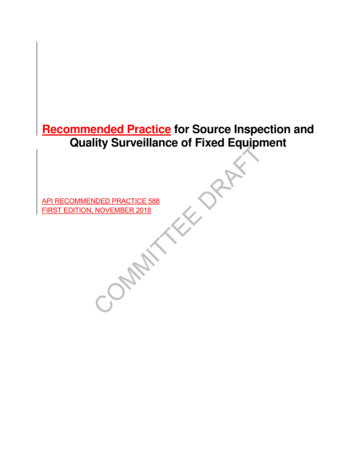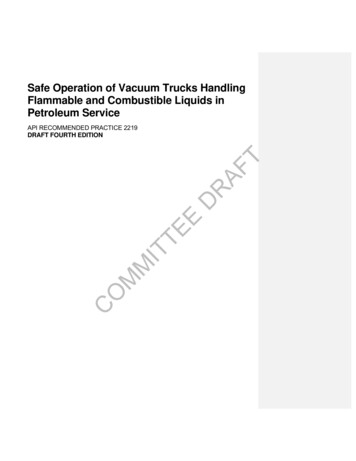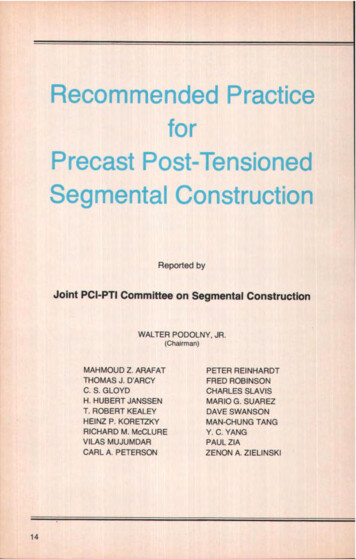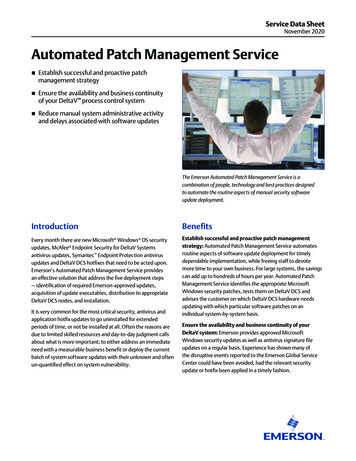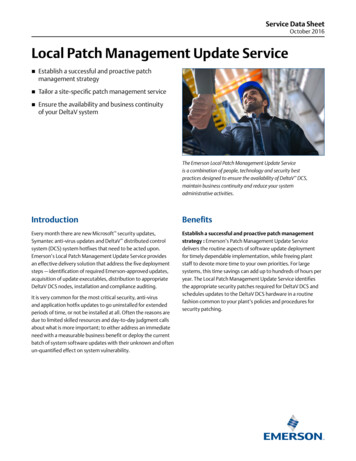
Transcription
Recommended Practice for PatchManagement of Control SystemsDecember 2008
Recommended Practice for Patch Management ofControl SystemsDecember 2008DHS National Cyber Security DivisionControl Systems Security ProgramACKNOWLEDGEMENTThis document was developed for the U.S. Department of Homeland Security (DHS) to provide guidancefor creating a patch management program for a control systems environment. The author team consistedof Steven Tom, Dale Christiansen, and Dan Berrett from the Idaho National Laboratory.For additional information or comments, please send inquires to the DHS Control Systems SecurityProgram at cssp@dhs.gov
ABSTRACTA key component in protecting a nation’s critical infrastructure and keyresources is the security of control systems. The term industrial control systemrefers to supervisory control and data acquisition, process control, distributedcontrol, and any other systems that control, monitor, and manage the nation’scritical infrastructure. Critical Infrastructure and Key Resources (CIKR) consistsof electric power generators, transmission systems, transportation systems, damand water systems, communication systems, chemical and petroleum systems,and other critical systems that cannot tolerate sudden interruptions in service.Simply stated, a control system gathers information and then performs a functionbased on its established parameters and the information it receives. The patchmanagement of industrial control systems software used in CIKR is inconsistentat best and nonexistent at worst. Patches are important to resolve securityvulnerabilities and functional issues. This report recommends patch managementpractices for consideration and deployment by industrial control systems assetowners.iii
CONTENTS1.INTRODUCTION . 11.1 Background . 12.PATCH MANAGEMENT PROGRAM . 22.1 Elements of a Good Patch Management Program . 22.1.1 Configuration Management Program. 22.1.2 Patch Management Plan. 32.1.3 Backup/Archive Plan . 32.1.4 Patch Testing. 32.1.5 Incident Response Plan . 42.1.6 Disaster Recovery Plan . 42.1.7 Unit Patching Operations:. 52.2 Specific Evaluation Issues. 53.PATCHING ANALYSIS . 63.1 Vulnerability Analysis . 63.1.1 Deployment. 83.1.2 Exposure . 83.1.3 Impact . 83.1.4 Simplicity . 83.2 Patch Process. 94.CONCLUSION . 105.RECOMMENDED READING REFERENCES. 106.WEBSITES LISTED. 11Appendix A—Issues . 13Appendix B—Unit Patch Process . 18Appendix C—Vulnerability Analysis. 21Appendix D—Acronyms & Definitions . 22v
vi
Recommended Practice for Patch Management ofControl Systems1.INTRODUCTIONA single solution does not exist that adequately addresses the patch management processes of bothtraditional information technology (IT) data networks and industrial control systems (ICSs). While ITpatching typically requires relatively frequent downtime to deploy critical patches, any sudden orunexpected downtime of ICSs can have serious operational consequences. As a result, there are morestringent requirements for patch validation prior to implementation in ICS networks. The Department ofHomeland Security (DHS) Control Systems Security Program (CSSP) recognizes that control systemsowners/operators should have an integrated plan that identifies a separate approach to patch managementfor ICS. This document specifically identifies issues and recommends practices for ICS patchmanagement in order to strengthen overall ICS security.1.1BackgroundICSs are deployed and used worldwide, spanning multiple industries and sectors. The advent,deployment, and maturity of universal communication protocols such as the Transmission ControlProtocol/Internet Protocol (TCP/IP) allow previously isolated control systems to be easily andeconomically joined, thus creating large integrated systems. The rapid pace of this evolution has allowedexisting IT cyber security issues to span into control systems, resulting in cross-sector issues that nowaffect all ICS users.Patches for ICS, particularly legacy systems, are typically applied either late or not at all. Somelegacy systems are not patched due to their service age, proprietary nature, perceived obsolescence orsimply because the patches are unavailable. ICS patches have traditionally addressed functionality andstability issues within the original code rather than enhance security.Isolated legacy systems have historically operated under the illusion of security through obscurity—ifa system has not been exploited to date, why would it be targeted now? While awareness ofvulnerabilities within these systems has increased, so has the interconnectivity between legacy and newerarchitectures. In the past, if a single ICS component on a segregated system failed, it could be easilytraced, isolated, shutdown, and repaired. Today, with the advent of increased network communications, asingle ICS component compromise could lead to a much larger cascading failure in adjacent networkedsystems by allowing unintended, exploitable access. Tracing and isolating the root cause of system failurein networked systems becomes much more difficult with failure leading to potentially far reachingconsequences.A few major issues between IT security and ICS security should to be addressed when developing acohesive patch management plan, (see more details in Appendix A). They include: Network integration of ICS Slower patch evolution Differences in patch deployment Abandoned and unmaintained software and hardware Reliable patch information Disclosure of vulnerabilities1
Embedded commercial off-the-shelf packages.Some industrial sectors require 99.999% or greater ICS uptime. This requirement relates to 5 minutesand 35 seconds or less allowable downtime per year for any reason, making unscheduled patching out ofthe question. Other industrial sectors may require patching activities at hundreds of sites, with a largenumber of units at each site, making a quick response difficult.To meet these challenges, a cohesive patch management plan must be developed. This plan is mosteffectively created when personnel from IT, IT security, process engineering, operations, and seniormanagement are actively involved.2.PATCH MANAGEMENT PROGRAMManagement policies are codified as plans that direct company procedures. A good patchmanagement program includes elements of the following plans: Configuration Management Plan, PatchManagement Plan, Patch Testing, Backup/Archive Plan, Incident Response Plan, and Disaster RecoveryPlan. Each of these plans requires input and approval from all affected organizations, with necessarydirection and support from senior management.2.1Elements of a Good Patch Management ProgramSeveral key practices or elements are recommended for any good patch management program. Theseelements are mentioned in the sections that follow.2.1.1Configuration Management ProgramA configuration management program should consider the following elements: The asset owner should maintain a current, functional software code library containing the mostrecent, stable, deployed software versions used in the ICS (including configuration files for switches,routers, file servers, database servers, and printers). Controls should prevent unauthorized access orchanges to operational code. A current hardware inventory of all control systems equipment should be maintained and madeavailable to authorized personnel only. This inventory should be cross-referenced to the softwarecode library. A current network schematic map locating wiring, junction boxes, and connections for datacommunications should be maintained. Configuration documentation including schematics and inventory lists should be controlled to preventpublic or casual access. Access, including update capabilities, should be limited to authorized staff. An archive of at least one or more revisions of the older production code should be maintained in aseparate and secure location. An archive of the software library, hardware inventory, current configuration, and schematics shouldbe maintained on a separate server and in a separate physical location than the production system. The policies and procedures related to the configuration management plan are disseminated,reviewed, and updated on a periodic basis. It is recommended that a Configuration Control Board be used to monitor, authorize, and controlchanges to the control systems configuration.2
To review additional references on the configuration management program see “Guide to IndustrialControl Systems (ICS) Security,” September 2008, National Institute of Standards and Technology(NIST), 800-82 Final Public Draft, Section 6.2.4, “Configuration Management.” For greater detail see“Information Security,” December 2007, National Institute of Standards and Technology (NIST), SpecialPublication 800-53, Revision 2, Appendix F-CM.2.1.2Patch Management PlanConsideration should be given to several elements in the patch management plan. For example: Vulnerability and exposure reviews should be conducted by personnel knowledgeable of the systemand its usage in conjunction with those who are accountable for those systems. These reviews shouldbe convened to examine vulnerability and exposure when an exploit is identified, or as a preventativeaction when cyber security weaknesses are discovered. These personnel must have the authority todecide on the urgency of patching activities. Note: Scheduling of the activity will be a businessdecision. a Urgency reviews should be conducted to evaluate the risk to operations and determine if immediateaction is needed (i.e., patching or implementing a work-around) or if action can be delayed or deemedunnecessary at this time. Deployment of patches or other modifications to the system may nullify the ICS warranty, dependingon the vendor and system. Arrangements should be made with vendors to address this issue beforepatch deployment.2.1.3Backup/Archive PlanThe asset owner should maintain a current and functional backup/archive. This archive should becreated and/or updated prior to any patching activities and provides a last, “good” snapshot of thefunctional, production system. The plan should describe: The frequency of the backup The process and functional requirements of creating the archive The backup verification procedures The backup retention period The physical storage (location, duplication, etc.) requirements.2.1.4Patch TestingAs mentioned earlier, patch testing is of special importance in control systems because of therequirement for very high uptime. The following recommendations should be included in patch testing b : Test bed/simulation hardware should be dedicated for testing purposes. A testing environment should be created that closely simulates the operational environment andallows for software compatibility testing.a.A discussion of patch management and patch testing was written by Jason Chan titled “Essentials of Patch ManagementPolicy and Practice,” January 31, 2004, and can be found on the PatchManagement.org website, hosted by ShavlikTechnologies, LLC.A white paper written by Nelson Ruest in 2004 for Wise Solutions titled “A Practical Guide for Patch Testing” providesadditional insight into patch testing and the general information on patch management.b.3
Planned tests should be conducted
This document was developed for the U.S. Department of Homeland Security (DHS) to provide guidance for creating a patch management program for a control systems environment.


